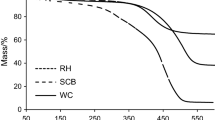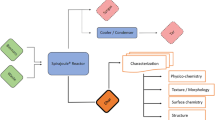Abstract
The byproduct “bio-char” produced by the pyrolysis process was characterized to investigate the properties and its appropriateness for energy application. The pyrolysis reaction was carried out at 300, 350, 400, and 450 °C and 1-h reaction holding time. The analytical techniques TGA/DTG, FT-IR, XRD, SEM, CHNS, and BET were used for the characterization of the different bio-char properties. Results showed that the carbon content in rice straw bio-char increased from 42.20 to 45.33%, with increasing pyrolysis temperatures from 300 to 450 °C. CHNS, XRD, FT-IR, and TGA analysis showed that the bio-char aromatic structure was rich in carbon and it demonstrated higher bio-char carbon stability at 450 °C. With increase in temperature from 300 to 450 °C, the specific surface area of the bio-chars was enhanced (1.17 to 6.60 m2/g). At higher temperatures, biomass macromolecules decomposed completely and bio-char became more porous in nature with voids created within the bio-char matrix. During the pyrolysis of the rice straw biomass, the sharp peaks of the crystalline structure were destroyed and less intensity broader peak appeared in the pyrolysis derived bio-chars. The atomic ratio of H/C and O/C decreased with increase in pyrolysis temperature from 300 to 450 °C. These low values indicate that the reaction temperature promoted the loss of oxygen and hydrogen.








Similar content being viewed by others
Data availability
All data of this manuscript are available upon request from the corresponding author.
References
Hu B, Wang K, Wu L, Yu SH, Antonietti M, Titirici MM (2010) Engineering carbon materials from the hydrothermal carbonization process of biomass. Adv Mater 22:813–828
**e J, Hse C, Shupe T, Hu T (2015) Physicochemical characterization of lignin recovered from microwave-assisted delignified lignocellulosic biomass for use in bio based materials. J Appl Polym Sci. https://doi.org/10.1002/APP.42635
Muthayya S, Sugimoto JD, Montgomery S, Maberly GF (2004) An overview of global rice production, supply, trade, and consumption. Ann NY Acad Sci 1324:7–14
Timmer CP, Block S, Dawe D (2010) Long-run dynamics of rice consumption, 1960–2050. In: Rice in the global economy: strategic research and policy issues for food security. 139–173
Balagurumurthy B, Srivastava V, Vinit J, kumar B, Biswas R, Singh R, Gupta P, Kumar SKLN, Singh R, Bhaskar T (2015) Value addition to rice straw through pyrolysis in hydrogen and nitrogen environments. Bioresource Technology 188:273–279
Enders A, Hanley K, Whitman T, Joseph S, Lehmann J (2012) Characterization of biochars to evaluate recalcitrance and agronomic performance. Bioresource Technol 114:644–653
KH Kim TS Kim SM Lee D Choi H Yeo IG Choi JW Choi 2013 Comparison of physicochemical features of biooils and biochars produced from various woody biomasses by fast pyrolysis Renewable Energy 50 188 195
Biswas B, Singh R, Kumar J, Singh R, Gupta P, Krishna BB, Bhaskar T (2018) Pyrolysis behaviors of rice straw under carbon dioxide for production of bio-oil. Renewable Energy 129:686–694
Chen H, Chen X, Qin Y, Wei J, Liu H (2017) Effect of torrefaction on the properties of rice straw high temperature pyrolysis char: pore structure aromaticity and gasification activity. Bioresource Technology 228:241–249
Phuong HT, Uddin MA, Kato Y (2015) Characterization of biochar from pyrolysis of rice husk and rice straw. J Biobased Mater Bioenergy 9:439–446
Biswas B, Pandey N, Bisht Y, Singh R, Kumar J, Bhaskar T (2017) Pyrolysis of agricultural biomass residues: comparative study of corn cob, wheat straw, rice straw and rice husk. Biores Technol 237:57–63
Wu W, Yang M, Feng Q, Grouther KM, Wang H, Lu H, Chen Y (2012) Chemical characterization of rice straw-derived biochar for soil amendment. Biomass Bioenerg 47:268–276
Wei S, Zhu M, Song J, Peng P (2017) Comprehensive characterization of biochars produced from three major crop straws of China. Bio Resources 12:3316–3330
Krishna BB, Biswas B, Ohri P, Kumar J, Singh R, Bhaskar T (2016) Pyrolysis of Cedrus deodara saw mill shavings in hydrogen and nitrogen atmosphere for the production of bio-oil. Renewable Energy 98:238–244
Putun AE, Ozbay N, Onal EP, Putun E (2005) Fixed-bed pyrolysis of cotton stalk for liquid and solid products. Fuel Process Technol 86:1207–1219
Garg R, Anand N, Kumar D (2016) Pyrolysis of babool seeds (Acacia nilotica) in a fixed bed reactor and bio-oil characterization. Renewable Energy 96:167–171
Fu P, Hu S, **ang J, Sun L, Su S, Wang J (2012) Evaluation of the porous structure development of chars from pyrolysis of rice straw: effects of pyrolysis temperature and heating rate. J Anal Appl Pyrolysis 98:177–183
Titiladunayo IF, McDonald AG, Fapetu OP (2012) Effect of temperature on bio-char product yield from selected lignocellulosic biomass in a pyrolysis process. Waste Biomass Valor 3:311–318
Imam T, Capareda S (2012) Characterization of bio-oil, syn-gas and bio-char from switchgrass pyrolysis at various temperatures. J Anal Appl Pyrol 93:170–177
Sharma RK, Wooten JB, Baliga VL, Lin X, Chan WG, Hajaligol MR (2004) Characterization of chars from pyrolysis of lignin. Fuel 83:1469–1482
Song W, Guo M (2012) Quality variations of poultry litter biochar generated at different pyrolysis temperatures. J Anal Appl Pyrolysis 94:138–145
Gaskin JW, Steiner C, Harris K, Das KC, Bibens B (2008) Effect of lowtemperature pyrolysis conditions on biochar for agricultural use. Am Soc Agric Biol Eng 51:2061–2069
Pereira RC, Kaal J, Arbestain MC, Lorenzo RP, Aitkenhead W, Hedley M, Macías F, Hindmarsh J, Maciá-Agulló JA (2011) Contribution to characterisation of biochar to estimate the labile fraction of carbon. Org Geochem 42:1331–1342
Wiedner K, Rumpel C, Steiner C, Pozzi A, Maas R, Glaser B (2013) Chemical evaluation of chars produced by thermochemical conversion (gasification, pyrolysis and hydrothermal carbonization) of agro-industrial biomass on a commercial scale. Biomass Bioenergy 59:264–278
Zhang Z, Zhu Z, Shen B, Liu L (2019) Insights into biochar and hydrochar production and applications: a review. Energy 171:581–598
Uchimiya M, Orlov A, Ramakrishnan G, Sistani K (2013) In situ and ex situ spectroscopic monitoring of bio-char’s surface functional groups. J Anal Appl Pyrol 102:53–59
Xu F, Yu J, Tesso T, Dowell F, Wang D (2013) Qualitative and quantitative analysis of lignocellulosic biomass using infrared techniques: a mini-review. Appl Energy 104:801–809
Ertas M, Alma MH (2010) Pyrolysis of laurel (Laurus nobilis L.) extraction residues in a fixed-bed reactor: characterization of bio-oil and bio-char. J Analytical and Applied Pyrolysis 88:22–29
Yang H, Yan R, Chen H, Lee DH, Zheng CG (2007) Characteristics of hemicellulose, cellulose, and lignin pyrolysis. Fuel 86:1781–1788
Keiluweit M, Nico PS, Johnson MG, Kleber M (2010) Dynamic molecular structure of plant biomass-derived black carbon (biochar). Environ Sci Technol 44:1247–1253
Yagmur E, Ozmak M, Aktas Z (2008) A novel method for production of activated carbon from waste tea by chemical activation with microwave energy. Fuel 87:278–285
Chen B, Zhou D, Zhu L (2008) Transitional adsorption and partition of nonpolar and polar aromaric contaminants by biochars of pine needles with different pyrolytic temperatures. Environ Sci Technol 42:5137–5143
Biswas B, Sahoo D, Sukumaran RK, Krishna BB, Kumar J, Reddy YS, Adarsh VP, Puthiyamadam A, Mallapureddy KK, Ummalyma SB, Bhaskar T (2022) Co-hydrothermal liquefaction of Phumdi and Paragrass an aquatic biomass: characterization of bio-oil, aqueous fraction and solid residue. J Energy Inst 102:247–255
Sakhakarmy M, Tian S, Raymond L et al (2021) Printability study of self-supporting graphene oxide-laponite nanocomposites for 3D printing applications. Int J Adv Manuf Technol 114:343–355
Acknowledgements
The authors thank the Director, CSIR-Indian Institute of Petroleum, Dehradun for his constant encouragement and support and AcSIR for granting permission to conduct this research work at CSIR-IIP. Authors thank the Analytical Science Division (ASD) of CSIR-IIP for NMR, FT-IR, and XRD analyses.
Author information
Authors and Affiliations
Contributions
Bijoy Biswas: conceptualization, investigation, methodology, writing—original draft, Putrakumar Balla: investigation, editing, Bhavya B Krishna: writing—review and editing, Sushil Adhikari: writing—review and editing, Thallada Bhaskar: conceptualization, supervision, writing—review and editing.
Corresponding author
Ethics declarations
Ethics approval
The authors declare that the manuscript has not been published previously.
Competing interests
The authors declare no competing interests.
Additional information
Publisher's note
Springer Nature remains neutral with regard to jurisdictional claims in published maps and institutional affiliations.
Rights and permissions
Springer Nature or its licensor holds exclusive rights to this article under a publishing agreement with the author(s) or other rightsholder(s); author self-archiving of the accepted manuscript version of this article is solely governed by the terms of such publishing agreement and applicable law.
About this article
Cite this article
Biswas, B., Balla, P., Krishna, B.B. et al. Physiochemical characteristics of bio-char derived from pyrolysis of rice straw under different temperatures. Biomass Conv. Bioref. 14, 12775–12783 (2024). https://doi.org/10.1007/s13399-022-03261-y
Received:
Revised:
Accepted:
Published:
Issue Date:
DOI: https://doi.org/10.1007/s13399-022-03261-y




